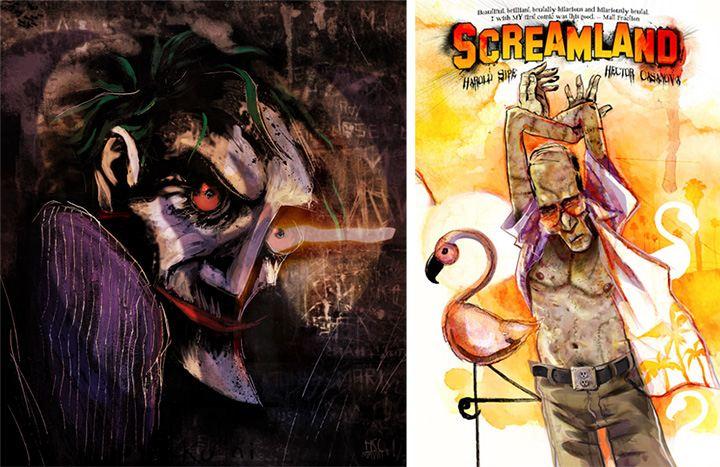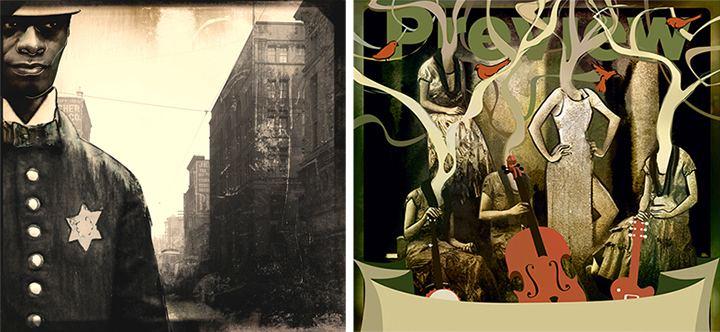The Q&A: Hector Casanova
Q: Originally from Mexico, what are some of your favorite things about living and working in the Midwest?
A: I was born and spent all my childhood in Mexico City. As a teenager I moved to the US, and between my teens and my twenties I moved a lot (Tennesee, Pittsburgh PA, Vermont, San Francisco, NYC, Iowa and Kansas City. Kansas City is (against all expectations) my favorite of all of these towns, and it is where I have been for the last 20 years. It is not too big, not too small, and has an incredibly vibrant arts community.
Q: Do you keep a sketchbook? What is the balance between the art you create on paper [or other analog medium] versus in the computer?
A: Yes, I started keeping a sketchbook at 15, and never stopped. I have two sketchbooks going simultaneously at any given time: my main personal sketchbook, where I doodle and document my thoughts and snippets of experiences and observations, and I can be free to "mess up" and there is no preciousness. I collage ephemera from whatever is happening in my life on there: concert ticket stubs, museum brochures, etc.
A few years ago I also started keeping a separate "work" sketchbook, where I do all my ideation for illustration assignments. That way I can keep my "job" sketching separate from my personal sketching, and so I could show sketches directly to my editor or art director and not worry that they may stumble upon some Tijuana Bible-type doodle I may have absentmindedly drawn.
As far as analog vs digital: Coming out of art school, my work was mixed media and experimental, incorporating painting, drawing, and occasionally 3D elements. Then I was hired as staff illustrator at the Kansas City Star (KC's daily newspaper), where I worked for about 15 years. As a newspaper artist, I had to manage very short deadlines and a need for quick revisions. That, compounded with the print quality on newsprint, led my work to evolve over time from 90% analog to 90% digital. Before I only used Photoshop to do final tweaks, but overtime, after doing sketches on paper, I would execute the bulk of the work on Photoshop, Painter or Illustrator. After I left the newspaper a couple of years ago, I decided to get back to making more tactile art, with as little computer as possible... so I have been working on murals these last two years... and that's as far from sitting at a desk as it can get.
Q: What is the most important item in your studio?
A: My sketchbooks! Everything starts in my sketchbook, as that's where I am able to brainstorm, warm up, doodle, and let my brain and fingers relax into an art-making zen state without fear of wasting materials or making mistakes.
Q: How do you know when the art is finished?
A: Usually because the deadline is upon me. The problem of having high standards for yourself is the tendency to fixate on things in your work that could always be better. If it weren’t for deadlines, I'd be tempted to keep working and reworking a piece in search for "perfection." But I also find that the more that I obsess, the more rigid the final piece turns out. So short deadlines can be a boon.
Q: What was your favorite book as a child? What is the best book you’ve recently read?
A: As a child, I used to devour the Choose Your Own Adventure series of books. That, and Spider-Man and Fantastic Fourcomic books comprised 90% of my reading. A book I am in the middle of now, that I am thoroughly enjoying is The Gift, by Lewis Hyde—a historical and philosophical contemplation on the nature and role of "gifts" in various societies, from the outmoded patriarchal views of women as "giftable" property to the notion of talent as a "gift.”
Q: If you had to choose one medium to work in for an entire year, eliminating all others, what medium would you choose?
A: That's a tough one. For Illustration work, I would say "Photoshop", as it allows me to digitally do everything I would want to do in my work in real life: draw, paint, collage, etc. But I dislike that the final result is just pixels. I like having the tangible, physical object that the artist directly imbued with their energy, focus and attention. Art made by hand is talismanic. So, for my personal work I would say "mixed media"... (primarily ink, watercolors and collage on paper...)
Q: What elements of daily life exert the most influence on your work practice?
A: Music. I need music to work. It helps me calibrate and get into the zone. For me, it's practically impossible to get started on an art project without music.
Q: What was the [Thunderbolt] painting or drawing or film or otherwise that most affected your approach to art?
A: When I was in high school, coming across Bill Sienkiewicz's book Stray Toasters changed my life. It is a beautiful, freaky, mixed media graphic novel that incorporated drawing, painting, mixed media assemblage, various rendering styles—unlike anything I had ever seen before. I already wanted to be an artist, but that book made me realize art and comics that should push boundaries. It opened my eyes to the fact that following established traditions and forms are just one way of making art, and so much more surprise and delight laid in the uncharted territories.
Q: Who was the [Thunderbolt] teacher or mentor or visiting artist who most influenced you early in your training or career?
Tom Dolphens was an adjunct instructor at the Kansas City Art Institute, but also the Assistant Managing Editor at the Kansas City Star. He had enough faith in my talent to hire me as a staff illustrator when I was just a year out of college, and made my dream of "drawing for a living" come true. The steady workflow of newspaper illustration allowed me to experiment, try different styles and media, and never get bored. In my first 8 years there, I was making 2-3 illustrations a week. That job gave me tons of experience and exposure, and was crucial in establishing my career.
Q: What would be your last supper?
A: Enchiladas de Mole (MOH-leh). There is nothing that is not made better by Mole sauce—even impending death.
Héctor Casanova is Assistant Professor of Illustration at the Kansas City Art Institute and has been working as a fine and graphic artist for
over 15 years. As a staff artist at The Kansas City Star ('99-'15), he illustrated hundreds of articles and won a handful of awards. His work ranges from editorial illustration
and comics to murals and gallery installations.
Hector will be a guest at Kansas City Comicon (Aug.12-14). I'll be
doing Live Art with the band Freight Train Rabbit Killeron Friday 8/12 (also at KC Comicon)
www.facebook.com/therealhectorcasanova
Twitter: @hectorcasanova





